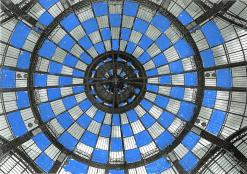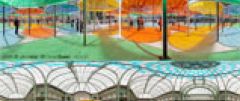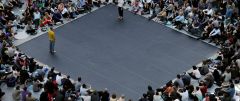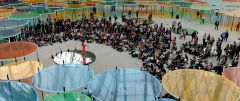© Daniel Buren, ADAGP, Paris
The day, the night
MS: Light plays a very important role in this project and the nave of the Grand Palais is particularly sensitive to that: a cloud passing in front of the sun radically changes the light. And since the exhibition is open until midnight, it also takes place at night, which requires electric lighting. How did you deal with these issues?
DB: I think that my work will be at its best when the sun is shining. Without the sun it will not only be different but amputated of one of its raisons d’être. That is one of the risks inherent to such an approach. As is often the case in my work, the piece depends not only on the setting, but on the climate, the light, the sun, clouds, rain and so on. It is the combination of these weather conditions which characterises the work and it is the effect they have on one another which, in the end, makes the work. Even if individual visitors might prefer one state to another. Between the opening of the exhibition in early May and its closing at the end of June we should have a few sunny days in Paris.
Night time is another story all together because the electric lighting installed on the ring around the dome in the nave, more than 30 metres from the ground, will sweep over the whole structure from north to south, east to west and back again.
I must say, right now, as we are talking, although we are familiar with the potential of the lighting systems we are going to use, I will have to see it with my own eyes to know what the effect will be, especially since all the electronic programs that control the light have to be adjusted in situ and therefore at the last minute. It is unfortunately far too soon to tell you much more. But there is one thing I am sure of: it will be a very different piece by day and by night. The electric lighting will add quite a different dimension, which will go well beyond just lighting the work and the spaces.







 Daniel Buren, Photo-souvenir : Esquisse graphique pour la coupole du Grand Palais
Daniel Buren, Photo-souvenir : Esquisse graphique pour la coupole du Grand Palais